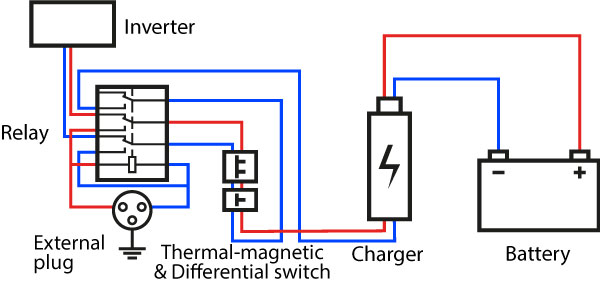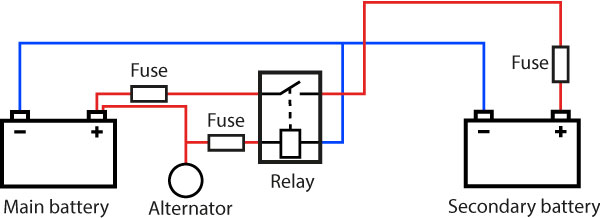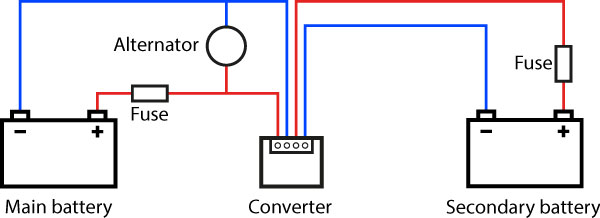If you want a battery that has a very good price-performance ratio, AGM batteries are what you are looking for. Keep reading our post and you will discover the most outstanding features of these batteries. In addition, as nothing is perfect, we will also talk about its not so strong points
AGM solar batteries and their most important features
AGM solar batteries are the most popular among van owners, as they have very good performance, are very versatile and are priced a little lower than gel batteries. The most significant feature of these batteries is that they have an Absorbed Glass Mat that is impregnated with the electrolyte by capillary action.
Want to buy an AGM battery for your van?
Performance and life of AGM batteries
In terms of performance, AGM batteries accept very high charge and discharge currents very well, which increases the number of charge and discharge cycles they are capable of delivering, so they have a fairly long lifespan. In addition, they can deliver high currents in the first few seconds. On the downside, AGM batteries do not perform very well when subjected to very high temperatures or extreme climates, so it is recommended that they are installed in an indoor location with a certain degree of thermal insulation to improve their efficiency and durability.
The life span of a battery is determined by the number of charge and discharge cycles it is capable of withstanding. So if, before buying a battery, you want to know how long it can last, approximately, look for the number of charge and discharge cycles.
Installation conditions of AGM solar batteries
This type of sealed batteries can be installed in any position, since, being sealed, there is no danger of leakage. However, to ensure optimum performance and durability, installation in its natural position, i.e. with the battery terminals facing upwards, is recommended.
Also, as mentioned above, AGM batteries should be installed indoors, away from heat sources and where the temperature is kept cool. It is also recommended that they have a certain amount of space so that the heat given off by the battery can dissipate.
how to charge an AGM battery?
To keep an auxiliary battery charged in your camper van you have several possibilities. The best option is to make a combination of several of them, to ensure a sufficient power supply and that the battery is never discharged below its recommended limit. The 3 most commonly used methods in a camper van or motorhome are as follows:
Charging an AGM battery using solar panels
Having a solar panel in your van will give you a freedom and autonomy that you will greatly appreciate. We believe that it marks a before and after, especially for those people who are not usually users of campgrounds or motorhome areas. In addition, once the initial outlay for the installation has been made, it is free! If you live or travel in a van, being self-sufficient is very important, and if we can be so by taking advantage of an inexhaustible natural resource, all the better.
It is obvious that for your AGM battery to be charged using solar energy you will have to install a solar panel, but you know what other element is essential A solar regulator, preferably a MPPT regulator (see on Amazon) which, although more expensive, manages to generate between 20% and 30% more energy than PWM. Another point to keep in mind is that the solar regulator must be able to charge at the appropriate intensity for the size of battery you have and at the voltage that is recommended in each charging stage.

Charging an AGM battery using a battery charger
If you are a visitor to campgrounds or RV areas you need to have a battery charger in your van. Whether you have a fixed installation, with an external 220V socket, or you simply have a charger that you plug directly with an extension cord to the campsite socket, it is a must!
The ideal is that the battery charger allows to choose the type of battery that you want to load or to configure manually the voltage to which it will load in each one of the phases, since the AGM batteries load to lower voltages that the traditional lead-acid ones and to variable voltages according to the load stage. If charging is not carried out correctly, the life of the battery could be affected. In addition, an AGM battery should not be equalized. Our recommendation is the Victron Energy smart battery charger (see on Amazon), in that link you will find different charging capacities and voltages, remember to choose the one that best suits your battery.

Charging an AGM battery via the main battery or the alternator
This is another charging method that we consider almost indispensable in a camper, as the auxiliary battery will be charging, if needed, while we are driving with the van which could be of great help on those short days when there is not much sunlight.
To charge the battery through the main battery or the van’s alternator there are at least two ways that are most commonly used:
- With a battery separator relay (see on Amazon): this relay can be manual or automatic and will simply take care of connecting the secondary battery with the van battery. Depending on the connection mode of the relay you install, when the relay receives a voltage higher than its activation voltage, which is usually between 13 and 13.8V, the relay will activate and connect the two batteries. At the same time it will disconnect them when this voltage drops. If you want to know more about its operation read our entry relays, converters and boosters.

It is advisable to install a switch to be able to disconnect the relay and the batteries before turning off the vehicle or when you drive with the auxiliary battery already charged. Remember to activate it, if you need to charge your battery, when the engine of your van is already running and always deactivate it before switching off the engine. If you forget and leave it connected when the vehicle is off, you can jeopardize both the charge and the life of the main battery.
- With a converter (see on Amazon) or a booster converter. These devices will do wonders for preserving the life of your auxiliary battery, as they are able to give a stable and specific output voltage, which can usually be set between 10V and 15V, from an input current that can have a variable voltage within a range, which is usually between 10V and 17V in 12V devices. In addition, most of them include a step-charging algorithm that allows the batteries to be optimally charged and thus extend their lifetime. These devices are the ones we recommend for this type of charging. We know they are not cheap devices, but if you can afford one our advice is to do it, without any doubt.

Our conclusion and recommendation for charging the auxiliary battery is to have a combination of different methods that you think can give you more autonomy, depending on the type of user you are, for example:
- If you do not usually go to campgrounds or motorhome areas: we believe that the best is a combination between a solar panel + MPPT regulator + converter or booster. You will have the solar panel to charge the battery while you are parked and the alternator and booster when the engine is running. This could also be useful in case the sun of the day is not enough, with starting the engine for a while you could recharge it.
- If you are a user of campsites and caravan areas: In this case, a charger is indispensable, whether you install it in a fixed way, with an external plug or use it as a support with an extension cord, we think it is a great option to have it.
We in our van opted for the following combination, which does not have to be the best, far from it:
- A 455W PERC monocrystalline solar panel.
- A 100V 30A MPPT SRNE solar controller with DC output.
- A Victron Energy Orion-tr Smart 12/12-30A converter (see on Amazon).
- A Victron Blue Smart battery charger (see on Amazon).
- An Ultracell gel battery. This Ultracell 100Ah gel battery is available on Amazon.
Recommended charging voltages in an AGM battery
| ABS (absorption) | FLOAT | STORAGE | RECONDITION Max V at % of Inom |
|---|---|---|---|
| 14,4V | 13,8V | 13,2V | 16,2V at 8 % max. 1 h |
Remember that an AGM battery should never be equalized.
Do AGM batteries need periodic maintenance?
AGM batteries are hermetically sealed, so they do not require any maintenance or periodic checks of acid levels. In addition, they are protected against gassing and liquid spillage.
Advantages of AGM batteries
- They offer a large number of charge and discharge cycles.
- They deliver high current during the first few seconds.
- They accept high charge and discharge currents.
- They are a little cheaper than gel batteries.
- They do not need maintenance.
- Although their installation is recommended in their natural position, if there is no other choice, they can be installed in any other position.
- They are sealed batteries, they do not need ventilation because they do not emit gases neither there is risk of spills.
Disadvantages of AGM batteries
- Lower resistance to extreme temperatures.
- Although their useful life is quite long, they have a lower durability than gel batteries.
Opinions and final conclusions on AGM batteries and their price
Those of us who have camperized or are camperizing a van know that every euro counts, so if you want quality equipment and good performance, but you need to spend just enough, we believe that an AGM battery is the best option for you. If you choose this type of battery you will have the advantages of installing a sealed and maintenance free battery, with a very good overall performance and saving a few eurillos if you compare it with a gel battery. It is not for nothing that they are the most popular among users.
All the schemes shown here are merely orientative. Always consult the documentation of the manufacturer of your devices because there may be variations.
Frequently asked questions from users about AGM batteries
Finally, we want to collect in this section the questions that users ask us about AGM batteries and that we believe that they can be useful for the rest of the community. If you think that any question should be in this section, do not hesitate to write us.
The price of an AGM battery will depend on its brand and capacity. Roughly speaking, it could be said that the cost of an AGM battery of about 100Ah could be around 180€, depending on the brand.
Both AGM and gel batteries are hermetically sealed batteries, this means that there are no liquid spills if the batteries are lying down, but it does not mean that, although it is possible, it is advisable to install them in a different position than the natural one. AGM batteries should not be installed lying down as their performance and life may be affected. So, for greater safety and durability, install them in their natural position whenever possible.





